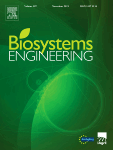Abstract:
Seed maturity in peanut ( Arachis hypogaea L.) determines economic return to a producer because of its impact on seed weight, and critically influences seed vigor and other quality characteristics. During seed development, the inner mesocarp layer of the pericarp (hull) transitions in color from white to black as the seed matures. The maturity assessment process involves the removal of the exocarp of the hull and visually categorizing the mesocarp color into varying color classes from immature (white, yellow, orange) to mature (brown, and black). This visual color classification is time consuming because the mesocarp must be manually removed. In addition, the visual classification process involves human assessment of colors, which leads to large variability of color classification from observer to observer. A more objective, digital imaging approach to peanut maturity is needed, optimally without the requirement of removal of the hull’s exocarp. This study examined the use of a hyperspectral imaging (HSI) process to determine pod maturity with intact pericarps. The HSI method leveraged spectral differences between mature and immature pods within a classification algorithm to identify the mature and immature pods. The results showed a high classification accuracy with consistency using samples from different years and cultivars. In addition, the proposed method was capable of estimating a continuous-valued, pixel-level maturity value for individual peanut pods, allowing for a valuable tool that can be utilized in seed quality research. This new method solves issues of labor intensity and subjective error that all current methods of peanut maturity determination have.
Links:
Citation:
S. Zou, Y. Tseng, A. Zare, D. Rowland, B. Tillman, and S. Yoon,"Peanut Maturity Classification using Hyperspectral Imagery" in Biosystems Engineering, vol. 188, pp. 165-177, 2019.@Article {Zou2019PeanutMaturity,
author = {Zou, S. and Tseng, Y. and Zare, A. and Rowland, D. and Tillman, B. and Yoon, S.},
title = {Peanut Maturity Classification using Hyperspectral Imagery},
journal = {Biosystems Engineering},
volume = {188},
pages = {165 -- 177}
year = {2019},
}
